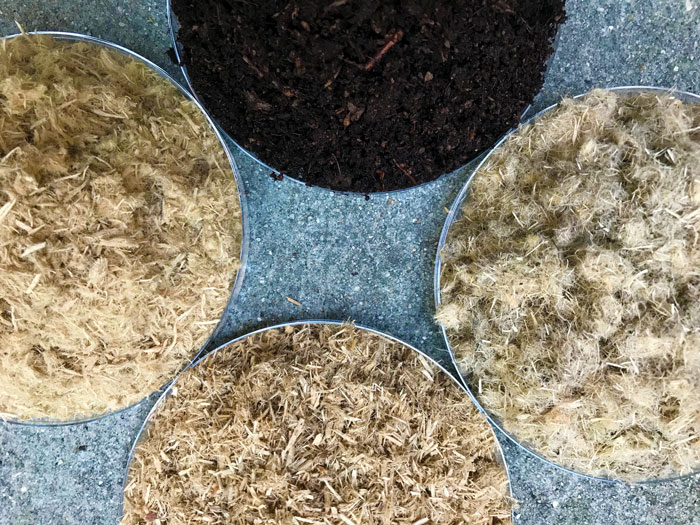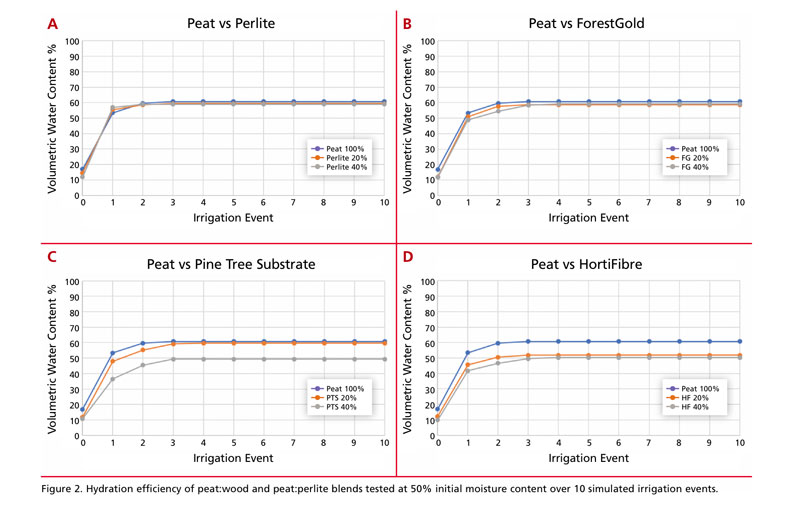5/1/2020
Good to the Last Drop
Brian A. Schulker, Dr. Brian E. Jackson & Dr. Bill Fonteno

Among the many areas of research in the Horticultural Substrates Laboratory at North Carolina State University pertaining to soilless substrate science, container plant production and controlled environment systems, none are more heavily emphasized and studied than water and wood.
Figure 1. Substrate materials tested for hydration efficiency were (clockwise from top) peat moss, ForestGold, Pine Tree Substrate and HortiFibre, which represent three different processing methods.
The first of those is pretty straightforward, in that we as plant/horticulture scientists are always working to improve water use, quality and efficiency. The second area of focus for our lab may not be as clear to many and that’s the intense investigation into wood substrate materials. The global attention, adoption, development, curiosity—and in many instances, concern surrounding wood substrate materials—are the driving forces behind our continued efforts. We’re currently working with leading industry colleagues and other academic partners across North America and in eight countries on four continents to collectively tackle the issues and opportunities relative to the future use of wood substrate materials.
Some of the recent substrate hydrological evaluations have included the wettability and water capture of various peat and wood product blends. In this article, we’ll discuss some recent data from a trial that included a representative wood product made from each of the three main processing technologies with Canadian peat as the base material.
The trial
ForestGold was selected as a disc-refined wood fiber, HortiFibre was chosen as the extruded wood fiber and a pine tree substrate (PTS) was manufactured from freshly harvested and processed 12-year old loblolly pine trees here at NC State University at the Substrate Processing and Research Center (SPARC) (Figure 1). As is true for all of our trials, we aim to test various wood products from commercial suppliers that represent the different processing technologies as part of our effort to piece together a thorough characterization (fingerprinting) of the similarities and differences of the various wood materials.
Each of the three wood products was blended with peat at 20% and 40% rates (by volume) after which each material had its moisture content adjusted (raised) to 50%. Peat was also blended with perlite at 20% and 40% for comparative purposes. Furthermore, peat was tested by itself (unamended) making a total of nine substrate treatments.
Standard testing for substrate wettability and hydration efficiency uses multiple initial moisture contents ranging from dry (33%) to wet (67%) so that the effect of initial testing moisture content on total hydration efficiency can be separated from the effect that the wood products themselves have on substrate hydration. However, for this article, we’ll only present and discuss data from tests made at the 50% moisture content.
Substrate samples were packed in clear plastic cores (to similar bulk densities) and then placed in the NCSU wettability testing units for analysis. A series of 10 simulated drip irrigation events were applied to the surface of the samples using 200 ml of water at each event. After each event, the volume of water that passed through the sample was collected and measured to determine the amount of water captured during each event. After the tenth irrigation, the samples were further analyzed to determine their maximum container capacities (water holding). Data were then graphed so that comparisons could be made between peat and the amendment of either wood or
perlite.

In Figure 2A, the data indicate that the addition of perlite at either 20% or 40% did not influence/chance the wettability (number of irrigation events to achieve maximum water holding indicated by the flattened line) or container capacity.
For ForestGold (Figure 2B), it took one additional irrigation event to reach maximum wettability as seen by the orange and gray lines not flattening until after irrigation three compared to irrigation two for 100% peat represented by the blue line. This difference is minimal and indicates the similarity (and uniformity of the blended materials) between peat and the disc-refined fiber.
For the PTS substrates (Figure 2C), the 20% amendment rate mirrored that of peat (no difference), but at the 40% rate the total water capture was lower by 10%. This has been seen before in other studies and is a result of the non-fiberous nature and difference in particle size and shape of the wood (due to the processing technique) that don’t hold as much water as other wood fiber types.
The HortiFibre had a similar response to the PTS, but in this case even the 20% inclusion rate reduced the total water capture, same as the 40% (Figure 2D). These data are also not surprising due to the large/thick particle size of the wood material and how drainage is often increased significantly when blended with peat. Despite the PTS and HortiFibre not capturing the same amount of water as ForestGold and perlite, it’s worth noting that the maximum wettability for all materials and blends was achieved after three events.
When looking at maximum container capacity (measured separately after the tenth irrigation events), the data support the wettability data that was previously discussed. Figure 3 shows the close similarity of total container capacity of peat plus 20% and 40% ForestGold. Again, showing the similarity of fiber size and blend uniformity to peat.
HortiFibre at 20% was also similar to peat, but at the 40% rate the capacity dropped 5%, which realistically isn’t much, but it does further show the influence of wood particle size, shape and percent on water-holding capacities and drainage. PTS and perlite were both mostly similar to the HortiFiber behavior, with 40% amendment decreasing total substrate water holding.

Aside from wettability and overall water capture (surface and subirrigation) of mixes that contain wood products, the biggest concern and learning curve that growers have faced is the adjustment to seeing the substrate surface dry out and look as though it needs to be irrigated when in actuality it does not. Figure 4 shows the nine substrates tested in this trial with the photo on the right (Figure 4A) taken one hour after hand irrigation in a greenhouse and Figure 4B showing the containers 24 hours later. The wood materials are visually lighter and have noticeably changed colors with some even appearing to have a “crust” over the surface. Even though these re-wet with no problem, it still presents a challenge to growers that must be learned and adjusted for.
As our domestic and international wood substrate research efforts continue to yield data, grower guidelines, best management practices and SOPs for crop production in 2020 and beyond, we’ll continue to distribute the information to the public as fast and freely as possible. The growing media industry is rising to the challenge to address current and future production needs and crop demands, and wood products may very well be one of the keys to future growth and success! GT
Brian Schulker is a graduate student studying Substrate Science at North Carolina State University. Brian Jackson is an Associate Professor and Bill Fonteno is a Professor at North Carolina State University. Communications can be sent to Brian at Brian_Jackson@ncsu.edu.